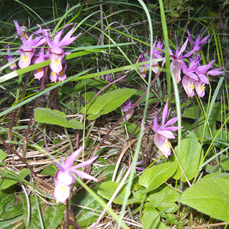
Leaving the dense, north facing forest, we walked up a south aspect, grassy slope. The yellow arnica and balsam root were amazing, interspersed with numerous, fragrant, light yellow bitterbrush flowers. These small, rose-like flowers attract night flying moths which provide an important food supply for the Common Poorwill. A small nightjar of the arid West, this Poorwill is the smallest member of it’s family in North America. It is one of the few birds known to hibernate in the winter. It is very well camouflaged, colored in browns, black and grey. This medium-sized bird is large headed with a tiny bill and very tiny feet. This bird can slow it’s metabolic rate and drop it’s temperature, going into a hibernation-like state known as torpor. In periods of cold weather, when insects are inactive, a poorwill may stay in torpor for several weeks. These birds hide during the day, emerging at dark to feed. They are very difficult to see, but several were heard during the week of the outing, flying past our house on Wilks Road near midnight.
Submitted by Daryl Calder

 RSS Feed
RSS Feed
